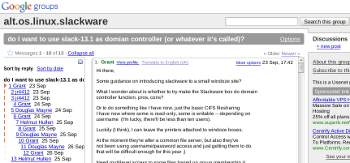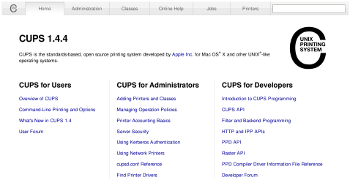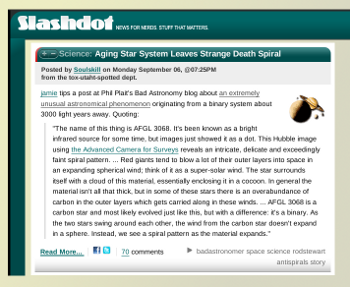 .
.
Tuesday, September 28, 2010
Saturday, September 25, 2010
Bye Bye Digg...Slashdot you're next
Here is an interesting story about the decline of news aggregator site, Digg. Digg changed their interface to one which would not load in a reasonable amount of time. That's dangerous, considering there is a plethora of other sites doing the same thing. Like a lot of others, I checked "out of there" in frustration and moved onto Reddit.
Coincidentally, Digg's interface follows in the footsteps of Slashdot which did something almost as bad with their interface. Sometimes their interface still works, but it seems to fail when you really want to read a story and the comments. For example, try loading all comments for this story:
MS holds iPhone funeral event
Coincidentally, Digg's interface follows in the footsteps of Slashdot which did something almost as bad with their interface. Sometimes their interface still works, but it seems to fail when you really want to read a story and the comments. For example, try loading all comments for this story:
MS holds iPhone funeral event
Friday, September 17, 2010
CUPS: Printing made easy in Slackware
Recent releases of Slackware use CUPS to setup and monitor print jobs. The primary interface to the application is browser based, and the service startup is controlled by /etc/rc.d/rc.cups. With the service running, the tool is accessed from the localhost on port 631 (i.e. http://localhost:631). It can also be used over the network- and in that case it may be better to use https for security. This is the main control window for CUPS, notice several click-able tabs:
 .
.
The latest release of the software has good support for a lot of printers, including the popular HP OfficeJet all-in-one devices.
In regard to the HP network devices, I have found that you can set the print URL manually using a socket and port 9100. For example, if the printer is located at address 192.168.1.101, then setup CUPS pointing to the URI:
socket://192.168.1.101:9100.
(You can simplify the name if your network is using a local DNS server. On small networks, the address alone is not too big of a hassle.) If you just want to print, the socket URI is a lot easier to enter, rather than HP's own syntax:
hp:/net/Photosmart_C7200_series?ip=192.168.1.101
This is a case where GNU/Linux took a long time to get this right, but now it is working perfectly and is actually easier than comparable setup offered in Windows. I think the latest integrated installer for HP devices is pretty crappy, but YMMV. Earlier Windows drivers refused install under Windows 2000, but that's expired now.
Another nice feature of the all-in-one devices is that the scanning function can be integrated into the Gimp. The only thing necessary is to create a link to the plugin:
$ ln -s /usr/bin/xsane ~/.gimp-2.6/plug-ins
With this linked, there will be new entries on Gimp's "File->Create" menu.
 .
.The latest release of the software has good support for a lot of printers, including the popular HP OfficeJet all-in-one devices.
More about HP all-in-one devices.
In regard to the HP network devices, I have found that you can set the print URL manually using a socket and port 9100. For example, if the printer is located at address 192.168.1.101, then setup CUPS pointing to the URI:
socket://192.168.1.101:9100.
(You can simplify the name if your network is using a local DNS server. On small networks, the address alone is not too big of a hassle.) If you just want to print, the socket URI is a lot easier to enter, rather than HP's own syntax:
hp:/net/Photosmart_C7200_series?ip=192.168.1.101
This is a case where GNU/Linux took a long time to get this right, but now it is working perfectly and is actually easier than comparable setup offered in Windows. I think the latest integrated installer for HP devices is pretty crappy, but YMMV. Earlier Windows drivers refused install under Windows 2000, but that's expired now.
Another nice feature of the all-in-one devices is that the scanning function can be integrated into the Gimp. The only thing necessary is to create a link to the plugin:
$ ln -s /usr/bin/xsane ~/.gimp-2.6/plug-ins
With this linked, there will be new entries on Gimp's "File->Create" menu.
Tuesday, September 14, 2010
Setup printing to Windows printer...
...when no printer driver exists for GNU/Linux (i.e. the printer is truly "Windows Only."
Here is a comp.os.linux.misc post about printing from GNU/Linux. Unfortunately, there wasn't much "discussion" as the original poster offered no follow up. That is the way it goes on usenet, I guess.
Update: 2010-10-17
The above discussion continued on a new thread, but remained unclosed/ambiguous as far as a real solution. Here is a link to the new thread. For some reason, my response was not included/captured by Google groups. Here it is copied directly from Pan:
Here is a comp.os.linux.misc post about printing from GNU/Linux. Unfortunately, there wasn't much "discussion" as the original poster offered no follow up. That is the way it goes on usenet, I guess.
Update: 2010-10-17
The above discussion continued on a new thread, but remained unclosed/ambiguous as far as a real solution. Here is a link to the new thread. For some reason, my response was not included/captured by Google groups. Here it is copied directly from Pan:
On Wed, 13 Oct 2010 16:42:56 -0500, Geico Caveman wrote:
> Well, this is really not a server, but this set of groups are
> collectively perhaps the best place to ask this question.
>
> I have a windows only printer that is attached to a windows machine
> (Windows XP Professional SP 3).
>
> I have followed this guide to redirect the port and set up a dummy
> postscript printer to allow unix hosts to print:
>
> http://iharder.sourceforge.net/current/macosx/winmacprinter/
>
>
Caveat: I don't have a Dell MFP 1125
I was not aware of "redirected" ports under Windows (as explained in the
above link). Thanks for that info. That gets around the "kludge" of a two
step process that I explained here:
http://groups.google.com/group/comp.os.linux.misc/msg/188d3a25f727dc19
I think that you should still try what I recommended in the above post.
That way you could test that certain parts of the problem are setup and
working correctly. Then as it is debugged, you can phase in the more
elegent solution incrementally. The link you found definitely results in
a more elegant final solution, but there are more items that must be
setup correctly all at once. BTW, regarding the winmacprinter setup
steps, I would be tempted to just the smb protocol when using cups
because it speaks smb. That way lpr is eliminated at both ends.
--
Douglas Mayne
Monday, September 13, 2010
This American Life...
This week's TAL had a very interesting story of a whistleblower on the Brooklyn beat of the New York police department, Adrian Schoolcraft. Schoolcraft blew the whistle on a defacto quota system which specified how many stops, searches, tickets, and arrests that an officer must make to keep in "good standing" with the department. Schoolcraft has tapes of the quota being announced at "roll call." The quota was reinforced using mildly ambiguous language designed to provide "just enough" wiggle room to provide deniabilty. The underlying message to the cops was clear: go get your quota. Courts have ruled that police quota systems are illegal. They are illegal because they lead to constitutional right violations, including unwarranted searches and detainment on trumped up charges. The story also documents that by focusing on petty crimes which generate ticket revenue to the city, more high profile crimes were being swept under the rug. This helped to meet their yearly statistic for crime reduction and keep the level of violent/serious crime down. Underreporting crimes helps the city's image because high crime is not good for tourism.
This show documents the dilemna the regular-honest-cop on the beat faces. He can meet his quota and hang on to his job long enough to collect his pension, or he can just do honest police work while not worrying about numbers, and then be forced off the job as a "bad cop." One chilling moment caught on tape is when a top NYPD official enters Schoolcraft's apartment with a SWAT team
and orders that Schoolcraft be taken into custody and placed in a psychiatric hospital. This is shades of "Catch 22,"
"We've got your boy."
It is one step away from the "disappeared" people of totalitarian regimes. Schoolcraft got out of the hospital because his father, a retired NYPD cop, knew about his son's whistleblowing and was not psychotic and got him released. The decision to "hospitalize" should be enough to put that official in jail. Don't hold your breath on that happening. The only punishment is likely to be monetary and hopefully a change in policy. Schoolcraft is now part of a $50 million class action. With the volume of evidence on side, he is very likely to succeed in his class action, and receive a big chunk of the $50 million in damages. The change in policy may come about in part because of the new tools that whistleblowers literally have in their pockets. The new tools may force that actual internal policy matches the stated public policy. If it does not, then the new technology makes documenting abuse very easy.
This is another instance of true courage and patriotism. It takes a lot less courage to "not rock the boat" and just go along with the status quo. What effect would Adrian Schoolcraft's complaints have had if they had "stayed in house" when the orders were coming from the very top and the rot goes right to the core?
This show documents the dilemna the regular-honest-cop on the beat faces. He can meet his quota and hang on to his job long enough to collect his pension, or he can just do honest police work while not worrying about numbers, and then be forced off the job as a "bad cop." One chilling moment caught on tape is when a top NYPD official enters Schoolcraft's apartment with a SWAT team
and orders that Schoolcraft be taken into custody and placed in a psychiatric hospital. This is shades of "Catch 22,"
"We've got your boy."
It is one step away from the "disappeared" people of totalitarian regimes. Schoolcraft got out of the hospital because his father, a retired NYPD cop, knew about his son's whistleblowing and was not psychotic and got him released. The decision to "hospitalize" should be enough to put that official in jail. Don't hold your breath on that happening. The only punishment is likely to be monetary and hopefully a change in policy. Schoolcraft is now part of a $50 million class action. With the volume of evidence on side, he is very likely to succeed in his class action, and receive a big chunk of the $50 million in damages. The change in policy may come about in part because of the new tools that whistleblowers literally have in their pockets. The new tools may force that actual internal policy matches the stated public policy. If it does not, then the new technology makes documenting abuse very easy.
This is another instance of true courage and patriotism. It takes a lot less courage to "not rock the boat" and just go along with the status quo. What effect would Adrian Schoolcraft's complaints have had if they had "stayed in house" when the orders were coming from the very top and the rot goes right to the core?
Tuesday, September 7, 2010
Literally, a death spiral
I saw this story posted on Slashdot in the general science category
 .
.
The link leads to a a Hubble telescope image of a very rare and hard to find object in the universe. It is hard to find because it is so faint; it is being illuminated by reflected starlight only. Wow! The Hubble used a very long exposure time to capture this image. (The area is glowing in the infrared, though.)
Update : 2010-09-07
I took a second look at the image and noticed two things: (1) the red giant star had generated vast amounts of carbon which have been shed into space (carbon nanosheets, nanoballs, hydrocarbons?) (2) its striking blue color.
Now, it could be that the color blue is present for the same reason that the sky is blue- all other colors are more scattered than blue wavelengths. Consider that all life on earth is carbon based, and must have originated in stars like this one; and consider that the remains of the red giant could re-coalesce into a planetary nebula that contains all of the elements necessary for life, especially if the debris from the star contains hydrogen and oxygen as well. In that case it's the building blocks for comets and planetary oceans. Now we can begin to draw comparisons to the "first world" of the Navajo creation myth. Interestingly, the "color" of the characters in the myth is important, with many characters centered on the color blue for some reason.
Oh, and Mandrake, did you realize that 70% of you is water?
 .
.The link leads to a a Hubble telescope image of a very rare and hard to find object in the universe. It is hard to find because it is so faint; it is being illuminated by reflected starlight only. Wow! The Hubble used a very long exposure time to capture this image. (The area is glowing in the infrared, though.)
Update : 2010-09-07
I took a second look at the image and noticed two things: (1) the red giant star had generated vast amounts of carbon which have been shed into space (carbon nanosheets, nanoballs, hydrocarbons?) (2) its striking blue color.
Now, it could be that the color blue is present for the same reason that the sky is blue- all other colors are more scattered than blue wavelengths. Consider that all life on earth is carbon based, and must have originated in stars like this one; and consider that the remains of the red giant could re-coalesce into a planetary nebula that contains all of the elements necessary for life, especially if the debris from the star contains hydrogen and oxygen as well. In that case it's the building blocks for comets and planetary oceans. Now we can begin to draw comparisons to the "first world" of the Navajo creation myth. Interestingly, the "color" of the characters in the myth is important, with many characters centered on the color blue for some reason.
Oh, and Mandrake, did you realize that 70% of you is water?
Subscribe to:
Posts (Atom)